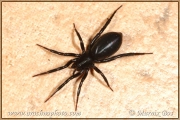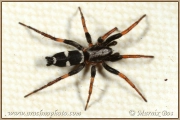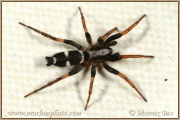The Gnaphosidae have long cylindrical spinnerets, which are quite far apart. This is in contrast to the Clubionidae, where they are close to each other. They are often dark spiders without clear markings on the abdomen, which usually hunt at night. These species hide during the day in a sac-shaped silken retreat. Some species have a white dotted pattern; these species mainly hunt during the day. In Europe about 420 species can be found, many of which are difficult to distinguish.










Genus Aphantaulax
The spiders of the genus Aphantaulax are black, with a white band in the middle of the carapace and a dotted pattern on the abdomen. They hunt during daytime, but can also be found hidden under stones. The spiders of this genus are very similar in appearance to those of the genus Poecilochroa.

Genus Callilepis
These spiders resemble ants and they move as such, as well as those of the genus Micaria. They are dark coloured with a distinct pattern of silver or golden hairs. They hunt ants during daytime, where they quickly jump the ant and give it a quick bite at the base of the antenna. After a short wait, the spider re-approaches the ant, bites it again and drags it to a retreat to eat it.

Genus Drassodes
These spiders all are grey-brown and have no markings on the abdomen making it difficult to distinguish them. They somewhat resemble Clubiona –-species. The spiders are nocturnal.


Genus Drassyllus
The spiders of this genus, as well as those of the genus Trachyzelotes, were previously assigned to the genus Zelotes. They strongly resemble them in both appearance and behavior. The dark brown to black spiders are nocturnal and hide during the day in a silken retreat under stones.


Genus Micaria
These ant-like spiders are black with a white dotted pattern and have a metallic shine that is clearly visible, especially in sunlight. They hunt during the day in low vegetation and under stones.

Genus Nomisia
The spiders of this genus closely resemble each other. They are yellowish brown, without clear markings on the abdomen, but with just a few black dots. These spiders are specialized in (daytime) hunting ants.


Genus Poecilochroa
These daytime hunting spiders are black, with a white dotted pattern on the body. The lower part of the legs is of a lighter colour than the upper part. Often they are active in the sun. The spiders of this genus are very similar to those of the genus Aphantaulax.

Genus Scotophaeus
These are relatively large spiders with a mouse-like appearance. The hair on the abdomen looks a bit oily. They live inside houses and mainly hunt at night.


Genus Trachyzelotes
The spiders of this genus, as well as those of the genus Drassyllus, were previously assigned to the genus Zelotes. They strongly resemble them in behavior and appearance. Like them, they are dark brown to black without any markings and they hunt at night. During the day they hide themselves in a silken retreat, for instance under stones.

Genus Zelotes
These spiders are predominantly black, without any markings on the body. Sometimes there is a difference in colour of the various leg segments. This can be used to distinguish a number of species from each other. The carapace is quite shiny. The spiders mainly hunt at night and during the day they dwell under rocks and low vegetation. Some species can be found running around in the sun.

